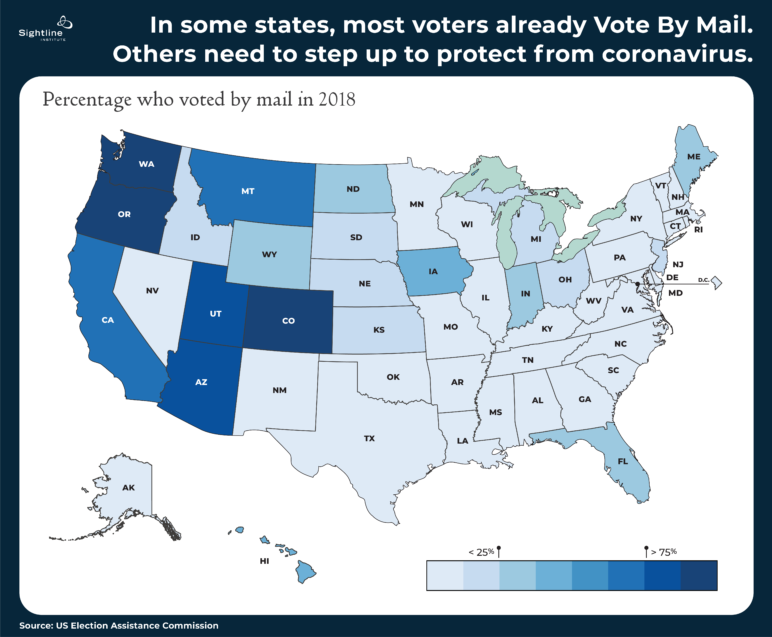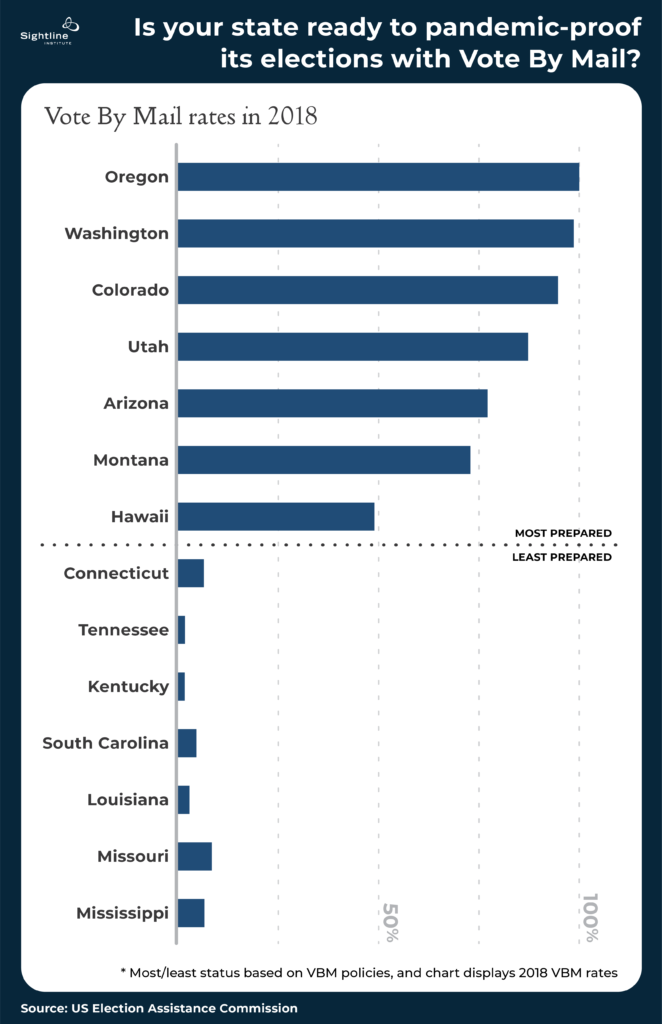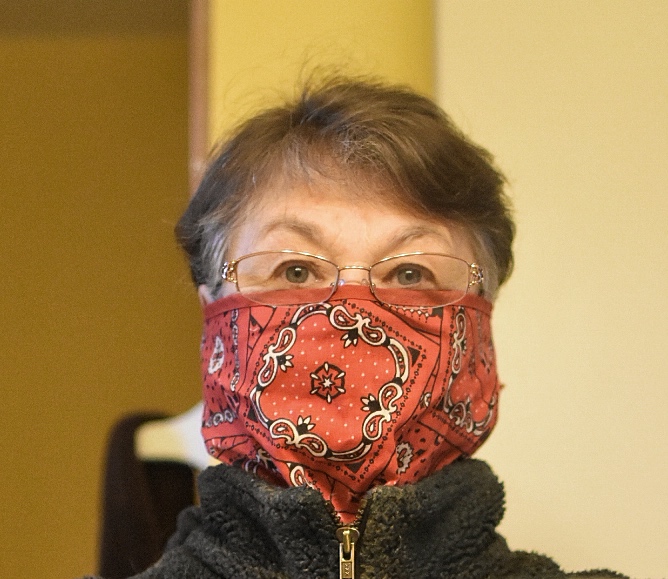Wisconsin’s chaotic April 7 primary amid lockdown orders made voters and election administrators painfully aware of what American voters could face in November. If states don’t prepare swiftly for another COVID-19 election season, more voters could be forced to choose between their health and their right to vote. In the meantime, even as pandemic fears raged, many other states where absentee voting is easy were quietly and confidently holding elections in which every voter could cast their ballot without fear. From home. No masks or life-risking maneuvers needed.
In 2018, all or most voters in many western states already voted with a ballot mailed to their home. They filled out their ballots at their leisure, often taking a few days to consider their choices, then dropped off signed, sealed, and barcoded ballots at a secure location or put it back in the mail. But heading east across the US, many other states make it difficult for voters to use an absentee ballot.
A second wave of coronavirus outbreaks could hit American communities this fall. Unless they start preparing now, the lightest blue states in the map below could see chaos on November 3 as voters run out of options—their state won’t let them vote absentee, but it isn’t safe for them to show up in-person and rub elbows with voters and poll workers (nearly half of whom are over 60). There’s still time for states to help more voters get a secure mailed ballot in November. Here’s what the most prepared states are doing right to prepare for COVID-19 election season, and where the least prepared states need to course-correct to run a safe, secure election.

Is your state ready for a COVID-19 election? Original Sightline Institute graphic by Devin Porter of Good Measures, available under our free use policy.
Best practices from the most prepared states
The most prepared states—Oregon, Washington, Colorado, Utah, Hawaii, Arizona and Montana—have collectively mailed-out many millions of ballots. States that usually mail out only a few ballots don’t need to recreate the wheel—they can borrow from more experienced states’ tried and true practices.
Mail a ballot to everyone.
Three states—Colorado, Oregon, Washignton—have been mailing ballots to every registered voter for years, decades even. Another two states—Hawaii and Utah—already planned to mail ballots to all voters in 2020. In Arizona, California, and Montana, most voters already vote absentee, so it’s not a big step for election administrators to mail ballots to everyone. In May, Montana county election administrators will mail ballots to every registered voter to vote in the June 2 primary. Arizona’s Secretary of State and county election directors are asking the legislature to allow them to do the same.
Thirteen additional states already have some experience mailing ballots to all registered voters. Alaska, Florida, Kansas, Maryland, Missouri and Wyoming all conduct certain elections completely by mail, while certain smaller or more rural counties or precincts in Nebraska, North Dakota,Nevada, New Jersey, Idaho, Minnesota, and New Mexico mail out all ballots.
Give voters a “single sign-up” option.
Short of mailing a ballot to every registered voter, Arizona, California, and Montana prepared for efficiently mailing out gobs of ballots by giving voters the option to sign-up just once to receive a ballot in the mail for all future elections. Less prepared states require voters to apply to vote by mail every year or election. Even if the voter knows she wants to keep getting her ballot in the mail, she has to keep filling out paperwork again each time. This isn’t just a burden on the voter, it’s a drain on election officials. It costs between $3.50 and $10 to process one absentee voting application, yet, nearly half or even two-thirds of absentee ballot applicants already applied in the last major election cycle.
Instead of processing applications year after year, states should allow election administrators to keep voters on a permanent vote-by-mail list. This saves county clerks the time and cost of mailing out, processing, and entering data from applications each year. It can also ease the election day crunch by spreading ballots over a longer time-frame—voters who automatically receive their ballot in the mail might fill it out and return it sooner, giving clerks more time to process it. Nevada, New Jersey, and Pennsylvania also give voters a single sign-up option, and many other states already have a permanent absentee list (Kansas, Massachusetts, Missouri, Nevada, New York, West Virginia, Wisconsin), they just need to let more voters add their names to it.
Track ballots with secure barcodes.
One of the most frustrating things that happened in the Wisconsin primary where the coronavirus situation was developing quickly, elections decisions were made last minute, and time was short, was that thousands, maybe tens of thousands, of voters never received their ballot. This wouldn’t happen in any of the thirty-three states that track all ballots using an individual ballot tracking tool like Ballot Scout or BallotTrax. Voters in those states may get text message updates telling them when their ballot is mailed, arrived, returned, and counted. Election administrators can see where the ballot is. If thousands of ballots suddenly stopped progressing after being mailed, a tracking system would have alerted both voters and election officials that something was up and they would have figured it out in time for every voter who requested a ballot to get it and vote. States that track each ballot with a unique barcode also enjoy heightened security, as only the voter associated with that barcode can vote that ballot.
Maintain clean and accurate voter lists.
When mailing out a lot of ballots, election officials want to be sure they are going to the voters’ current address. Clean voter roles help states run elections securely and efficiently. Prepared states keep their lists clean and accurate by allowing voters to securely register and update their information online, by automatically updating voters’ addresses when they change their address with the DMV or the post office, and by being a member of the Electronic Registration Information Center (ERIC) which alerts states when voters have moved or passed away.

Most- and least-prepared US states as we head toward another COVID-19 election season. Original Sightline Institute graphic by Devin Porter of Good Measures, available under our free use policy.
What the least prepared states need to change
Many states will need to make changes to keep elections and voters safe in November. These seven—Connecticut, Tennessee, Kentucky, South Carolina, Louisiana, Missouri, and Mississippi—have a suite of practices specially designed to hold them back.
No excuses.
The least prepared states all block voters from voting absentee unless they provide an “excuse,” such as illness or disability A national health emergency should be an adequate excuse during this pandemic. But even in non-pandemic elections, Americans shouldn’t have to proffer an excuse for access to the convenience, safety, and security of voting by mail. Only 16 states still require excuses, and four of those (Alabama, Indiana, West Virginia, and Delaware) have temporarily waived the excuse requirement because of COVID-19. Those should make the waiver permanent, and the other dozen should follow suit.
Drop the notary.
Bafflingly, a dozen states require absentee voters to get a notary or witness to sign their ballot.

Bafflingly, a dozen states require absentee voters to get a notary or witness to sign their ballot. Four of our least prepared states (Missouri, Mississippi, South Carolina, Louisiana) require a notary or witness. This doesn’t make the election more secure (if you are voting fraudulently, you can surely find one crony to be your witness), it does add an unnecessary step for voters, and it flies in the face of social distancing requirements this year. Those states need to join the modern era, for COVID-19 election season and beyond, and do what prepared states do—use signatures to verify voters’ identity.
Don’t throw ballots in the trash.
All the unprepared states do something almost unthinkable: they throw votes in the trash. If the voter forgot to sign the outer envelope, or their signature doesn’t match the signature on file, these states simply toss out that American’s vote. More than one-quarter of 2018 absentee ballots were flagged for signature problems—if all of those got tossed, that would add up to a lot of disenfranchised Americans!
Prepared states have some advice: notify the voter that there was a problem with their signature and give them a chance to prove their identity. This method is simple, fair, and ensures more voters have their votes counted. By giving voters a chance to fix any problems, all our most prepared states (along with half a dozen more states that give voters the opportunity to “cure”) accept 99 percent of all vote-at-home ballots.
Accept ballots mailed or dropped off on election day.
Especially for states where most voters have not voted absentee, it’s important to make the rules as clear as possible for voters. Voters accustomed to going to a polling place on election day may want to bring their ballot to a secure election center on election day, or drop it in a mailbox on election day. As it stands, all of the unprepared states would reject those ballots, silencing those voters. Trailing states should do what Idaho is doing for its May primary, and let voters drop off their ballot on election day, at a vote center or a mailbox, and have their vote count.
States can inoculate elections from this health crisis, protecting voters’ health and their right to vote as another COVID-19 election day approaches. But officials in states that are trailing behind must act quickly to catch up by November.
If you have more questions about voting by mail, we have a FAQ. If your state isn’t listed here but you are wondering how it is doing, we have an election status tracker here.
Kristin Eberhard is a director at Sightline Institute. She researches, writes about, and speaks about elections systems and democracy reform, with particular expertise on Vote By Mail and proportional representation. Eberhard lives in Oregon, an all-Vote By Mail state. She is available to discuss tested, safe, fair COVID-19 election practices, state by state. For interviews, speaking engagements, and media inquiries, contact Anna Fahey. Find all Eberhard’s latest research here.










